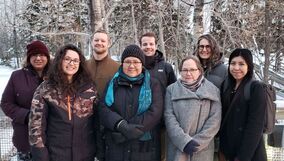Like other organizations in these uncertain time, CIER is adapting. We sat down with CIER Executive Director Merrell-Ann Phare to learn how CIER is rising to the challenges brought by COVID-19.
How is COVID-19 affecting First Nations and Inuit communities across Canada?
This is a difficult question to answer because this virus and the measures put in place to contain its spread are entirely unprecedented. We know that Indigenous communities – like all communities across Canada – are already being impacted and will continue to be impacted in many ways, and that the specific impacts will vary widely depending on the community. But we also know that many Indigenous communities have unique circumstances that means they will experience the virus differently than other places. During the H1N1 outbreak in 2009, for instance, Indigenous peoples were massively overrepresented in the number of hospitalizations, critically ill patients, and deaths that resulted from that virus.
We can think of many risk factors that might make some Indigenous communities more vulnerable to COVID-19. Communities that struggle with overcrowded housing, poverty, and food insecurity will have greater susceptibility to respiratory diseases. Northern communities that rely on the medevac air ambulance system could be easily overwhelmed by a sudden increase in critical illnesses. High food prices in remote communities may increase even more if supply chains are significantly disrupted. Yet at the same time communities are responding in all sorts of creative ways to support each other and stay safe in these uncertain times.
How is CIER rising to the challenge?
CIER does a lot of work in communities, which means that many of our projects and partnerships have been affected by the pandemic. We are working with our community partners to adjust timelines and devise creative solutions on a case-by-case basis.
Moving forward, CIER also plans to work closely with communities to help support them in these uncertain times. Communities know best what they need to prepare and respond to the spread of COVID-19, but this is an incredibly stressful and disruptive time that makes planning and implementing programs very difficult. Where we can add capacity, we will. Beyond this immediate response, we will explore ways to help communities bounce back over the long-term.
One thing that is critical at this time is having a collaborative and coordinated emergency response plan, which means that collaborative governance tables are more important than ever. This is a space that CIER is very familiar with through the Collaborative Leadership Initiative (CLI), which brings Indigenous and municipal leaders together to devise regional solutions to complex shared challenges. The CLI table provides an opportunity for these leaders to work on a develop a regional emergency response plan, both for this health crisis and for other future challenges.
How is COVID-19 affecting our environment and can we learn anything from it?
COVID-19 is changing the environment in numerous indirect ways by changing how humans are interacting with it. For example, I know that the Dene Nation is receiving funds to support their members going out on the land to avoid covert transmission. This is an example of Indigenous people relying on their traditional practices, and helps explain the need for and reason why [one of the many reasons why] Indigenous people continue to rely on their traditional land based skills. These types of examples help connect the dots for people about why “being out on the land” matters.

